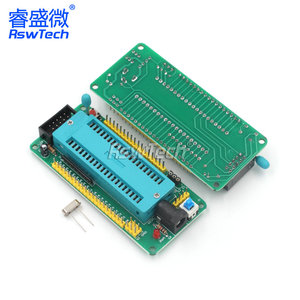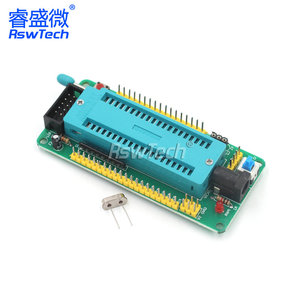(270 products available)


















































































































































































There are many types of 51 mcu development boards that wholesale buyers can consider, and each board type comes with unique attributes and advantages for various development requirements. The following is a list of the most common development board types:
The basic development boards have only the critical features needed for software and hardware interaction. They are a good option for simple projects or learning purposes because they are cheap and easy to use. Most include simple I/O capabilities and basic interfaces.
Expansion boards or shields are extra boards to add features like sensors, displays, or communication modules to the base project. These boards make it easy to grow the project without having to redesign anything from scratch. They allow users to attach additional features on the fly, making them versatile for complex projects.
In today's world, most of the activities are being done wirelessly. So, it is also a common and preferred choice to go for 51 development boards that have wireless communication like RF modules, Bluetooth, Wi-Fi, or Zigbee integrated into them. Such boards are purposely made for IoT projects where communication between devices is a necessity. They allow remote control and data transfer, hence being useful in many applications.
51 MCU development boards that come with touchscreen displays are intended for those buyerserk who are developing user-friendly interfaces. These boards/wireless communication not only give processing abilities but also visual and interactive capabilities without requiring additional components.
Development boards with GPS functionality are targeted towards projects that need location tracking or mapping. These boards give precise positioning data and are used in many automobile and outdoor adventure applications. When the GPS module is built into the 51 MCU development board, it eliminates the need for extra hardware and simplifies the development process.
In as much as there are diverse types of 51 mcu development boards there are certain factors that buyers should consider when selecting these boards to ensure that qualitative products are procured.
It is the board's gallery intended use that should define the choice of the board. A basic model is sufficient for simple tasks, while complex jobs may need boards with extra features, like wireless communication or a touchscreen interface. Locating one that meets the application's requirements in performance and compatibility is crucial to project success.
Development boards differ in prices depending on their specifications. Buyers should decide in detail what they actually need as that will dictate what solution can be provided within the budget. For simple applications, an inexpensive basic board will suffice, but it will probably need more expensive support hardware for more complex projects.
Although there are many development boards, it is important to consider going for boards produced by a certain brand that people have come to trust. When doing research on various boards, one should consider factors like durability, quality, materials used to make the product, and customer reviews. Moreover, boards from manufacturers with strong customer support and documentation are much more likely to be helpful when tackling development issues.
Different boards have different connectivity options like serial, USB, or I2C interfaces. Buyers should ensure the board has all the needed interfaces to connect to other peripherals or modules. Proper connectivity is crucial in ensuring a seamless and smooth integration process with other components of the project.
To safely and efficiently operate and use the 51 MCUs development boards, in-depth knowledge about their specifications is paramount.
Unlike the other MCUs, this one is known and popular for its 8051 microcontroller architecture. It integrates a certain clock speed, commonly around 12 MHz, with high efficiency for most operations, and common memory capacities are 32 KB for program memory and 256 Bytes for data memory. A lot of the 51 MCU development boards feature multiple I/O ports, timers, and serial communication interfaces, to begin with.
The common operating voltage on these development boards is between 5V and 15V. Most of these boards have expandable power supply options, i.e., batteries or external adapters. Option of different voltages for the components allows the users to use different peripherals without having to always think about their power source.
Most integrated 51 mcu development boards have features like short circuit protection, current protection, thermal protection, and over-voltage protection. They help in keeping the system safe and hence so desirable during development processes, especially when carrying out experiments or testing.
Dimensions vary depending on the complexity and detail of the board, but most are within the range of 15 x 10 cm to 20 x 15 cm. Many development enclosures are designed to be compact and can fit on a lot of work desks or inside prototypes. Besides protecting the components, the case also makes handling the development board during the projects easy and convenient.
The 51 MCU development boards support various IDEs and programming languages, such as C or Assembly Language. Common development environments include Keil and MCU 51 IDE. These software tools are very useful because they help in program development, debugging, and uploading of the code on the board.
When it comes to use, 51 MCU development boards are flexible and can be plugged into diverse projects. Following is a list of some common use cases for these boards.
Students and engineers use the boards to create basic projects to learn and understand programming, sensors, and interfacing. It is also a perfect board for prototyping as it allows users to test and evaluate their project concepts before final production. Because of their low cost and programming versatility, they are ideal for fun experiments and proof-of-concept designs.
51 MCU development boards are popularly used in DIY home automation to control devices wirelessly, such as lights, thermostats, and security systems. When combined with communication modules, they enable users to create smart home applications that can be controlled remotely, providing convenience and power to the homeowners.
Many developments use these boards in wearable technologies like fitness trackers and smartwatches. The board's small size makes the gadget portable, and its ability to communicate wirelessly enables data transmission to other devices. The incorporation of sensors on these boards allows the wearer to track different parameters like heart rate and movement.
In modern agriculture, these boards are used to develop systems for monitoring soil moisture, weather conditions, and crop health. When coupled with sensors, the boards collect and transmit data to help farmers make intelligent decisions about irrigation, fertilization, and pest control. This improves efficiency and crop yield.
MCUs development boards help in controlling motors, sensors, and other components in robotic systems. They enable the user to develop autonomous robots used for various applications such as industrial automation, exploration, and education. The programmability of the board makes the user able to implement different algorithms for control and decision-making.
A. Yes, it is suitable for small and large scale home automation projects. Although commonly used for prototyping, they can also be utilized for small scale commercial and large commercial projects if the board has robust features to support the end use requirements.
A. The 51 mcu development boards are compatible with widely available operating systems such as Linux and Windows operating systems, which makes them suitable for most applications.
Development boards 51 MCUs are housed in industrial cabinets, compact desktop enclosures, or commercial product casings, depending on their applications.
Users can enhance the lifecycle of the boards by protecting them from environmental exposure, using cooling systems to curb heat, and avoiding overloading the board with tasks.
In cases where the board is wrapped or put in a protective enclosure that can shield circuitry from moisture, extreme temperatures, and physical shock, then 51 mcu development boards can be used for outdoor activities.